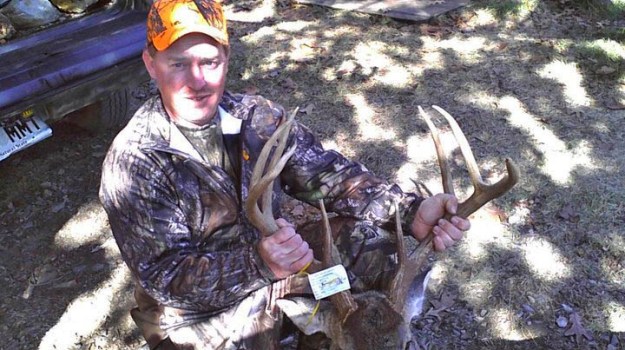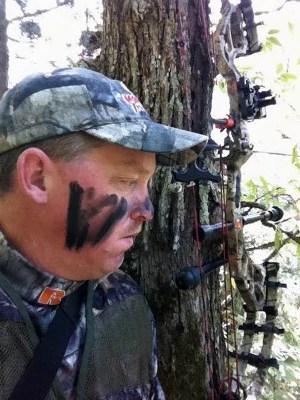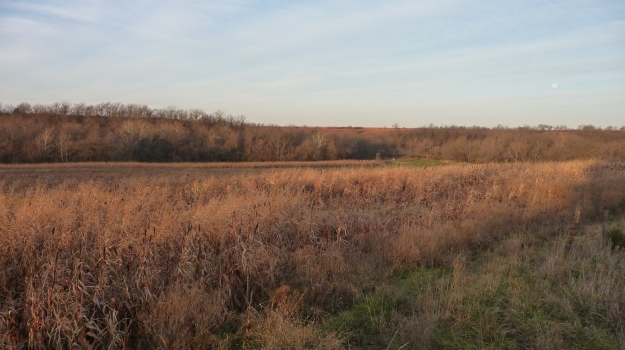
Editor’s Note: Parrish Elliott of Fairview, Tennessee, just outside of Nashville, has been a Mossy Oak Pro for 7 years, a deer hunter for 25 years and a bowhunter for 20 years and has taken more than 80 deer with his bow.
Before opening day of bow season, the deer in my area are usually in the agricultural fields. I try and stay as far away from those deer as I can and still be able to see them. I use my binoculars and generally remain in my truck to observe the deer. I have a spot, on one place that I hunt, that is 300-yards away from the agricultural fields. I can sit there in my truck and watch the deer as they feed and leave the field. But I do go into the hardwoods behind the fields and set-up game cameras to monitor the trails the deer take to and from the agricultural fields. I have seven game cameras on two-different plots of land that I hunt – about 300-total acres. Going into opening weekend this fall of the 2013 season, I already have identified four mature bucks that I want to hunt there.
On one 240-acre tract, the woods have had a selective timber cut done. But, all the big white oaks are left. This property has no hunting pressure except me and one other bowhunter. The second place, which is about 60 acres, has a corn field planted right next to the river bottom. That corn is a deer magnet, and the river bottom is a deer highway. I especially like this spot, because I can watch the deer in the corn field, and I can see the trails that they use to come into and go out of the corn.
 Two weeks into early bow season one year, I took a deer in this area. I nearly didn’t get a shot at him. As most hunters know, your odds are best when you have the wind in your face, but we can’t control the wind. Even if you get into your tree stand, and you’re facing into the wind, the wind often changes before or right after first light, and that’s what happened on this hunt. I had a nice 9-point buck that I had watched for about 20 minutes. As he came toward me, he kept throwing his head up like he smelled me. When he brought his head up, he would look straight at the tree and at me, however, he couldn’t see me, because I was wearing Mossy Oak camouflage.
Two weeks into early bow season one year, I took a deer in this area. I nearly didn’t get a shot at him. As most hunters know, your odds are best when you have the wind in your face, but we can’t control the wind. Even if you get into your tree stand, and you’re facing into the wind, the wind often changes before or right after first light, and that’s what happened on this hunt. I had a nice 9-point buck that I had watched for about 20 minutes. As he came toward me, he kept throwing his head up like he smelled me. When he brought his head up, he would look straight at the tree and at me, however, he couldn’t see me, because I was wearing Mossy Oak camouflage.
One thing that is important to remember in the early season is that deer don’t just feed on agriculture or acorns. Deer are browsers and feed on a wide variety of foods. This 9-pointer was meandering through the woods headed for a honeysuckle patch. In my area, honeysuckle is one of the deer’s preferred foods. I was watching a group of squirrels bouncing through the limbs eating acorns. When I thought I heard a deer walking, I turned and looked in that direction. I spotted deer legs in the thicket. I stood up and readied for the shot. When I saw how good the deer was, my nerves took over.
As the deer came in, I couldn’t take a shot, because he was walking straight to me. Occasionally, the wind would swirl. He would get a whiff of my odor and look straight at me. He had me pinpointed, but because my Mossy Oak Treestand camouflage blended in so well with the tree, the deer seemed to look through me. Finally, he turned and started walking toward the creek bed, looking away from me. I was able to get my shot off at 28 yards. My arrow went through his front shoulder and exited through his offside shoulder. I was shooting a Swhacker broadhead on my PSE Omen Pro. The buck only went about 15 yards after he took the arrow.
I learned on this hunt to:
- Look for places and food sources on the way to or from the deer’s primary food source. Remember, deer are browsers, and they eat a wide variety of foods.
- Use some type of odor eliminator. Even if you are facing into the wind when you climb into your tree stand, more than likely that wind won’t stay constant all morning long.
- Make the mental decision not to draw my bow if a deer is walking straight toward me, until the deer gets past me and presents either a quartering-away shot or a broadside shot.
Day 1: Four Tips for Early Bow Season with Mossy Oak’s Parrish Elliott
Tomorrow: The Downtown Buck Deer with Mossy Oak’s Parrish Elliott



























